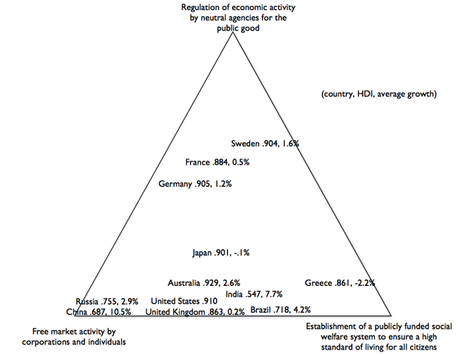
Professor Luciano Segreto lectured in Michigan this week on the subject of a comparison between US and European capitalisms. Segreto is professor of International Economic History, Financial History, and the History of Regional Economic Development at the University of Florence. His lecture was fascinating in many ways, but of special interest here is whether there is one capitalism or many. Segreto's view is that there are multiple capitalisms that have been implemented in various countries -- England, France, Germany, Italy, the United States, and Japan, to consider a short list; and that these systems of political economy differ in significant ways. He identifies different structures of the markets, different relations between technology and economic development, and significantly different ways in which finance and banking systems have been implemented as important dimensions of difference across these systems of political economy.
The idea that there are distinct versions of capitalism is not a new one. Peter Hall and David Soskice's Varieties of Capitalism: The Institutional Foundations of Comparative Advantage looks at recent work on the important institutional variations that exist across existing forms of market economies. Charles Sabel's historical investigations of alternative pathways of capitalist development represent one important line of thought on the question, and Frank Dobbin's investigation of the different ways that the technology of the railway were incorporated in Britain, France, and the United States represents another important line of thought. For Sabel the distinctions have to do with the ways in which skilled labor and workers were incorporated into the political economy (World of Possibilities: Flexibility and Mass Production in Western Industrialization (Studies in Modern Capitalism); link); for Dobbin it is the differences in political culture defining the role of state involvement in central economic institutions that made the largest difference (Forging Industrial Policy: The United States, Britain, and France in the Railway Age; link).
In listening to Professor Segreto I was drawn to a different way of analyzing the differences across historically realized capitalisms in the past century and a half. We might imagine that there are three "attractors" that define a modern capitalist political economy: the values associated with the market and independent decision making by corporations and entrepreneurs; the value associated with the establishment of regulations protecting the common good and the safety and health of the public; and the value associated with securing the welfare of the whole population, involving a social security system and a willingness to redistribute income and wealth through taxation. This suggests the following diagram:

The graph is offered only for the purpose of illustration of the idea. I have included the country's 2011 HDI (link) and 5-year growth rate (link), but I don't have data to allow scaling of these economies according to the three dimensions mentioned here. But I'm sure that a capable graduate student would be able to come up with some available measures to do a much more rigorous job of pacing national economies in this tri-polar graph. Measures of regulation might include degree to which key industries like energy, chemicals, pharmaceuticals, and food are effectively regulated by independent agencies. Measures of welfare-state commitments would include breadth of health system coverage, unemployment coverage, old age coverage, and percentage of GDP devoted to social programs. And measures of free markets might include the degree to which companies can make choices unencumbered by regulations on safety, labor relations, market concentration, etc., as well as the effective rate of corporate taxation.
The United States and the United Kingdom seem to be on the low side among OECD countries in terms of both effective regulation and commitment to social welfare principles; Russia and China seem to afford quite a wide scope of business freedom but limited regulation of environment and safety and limited commitment to a social safety net; Sweden, France, and Germany have substantially greater commitment to effective state regulation of industry and to a high social minimum; Greece seems to have had high social welfare commitments but relatively low regulation of industry; and so forth.
We might label the three extremes of the diagram as "unencumbered business/corporate system," "technocratic state," and "social welfare state."
It is significant that the political ideology of the right in the United States has for the past three decades waged a determined struggle against two of the poles of this analysis -- regulation and social welfare policies. Under the legislative and executive influence of politicians with this "small government" ideology, the political economy of the United States has been pushed further and further into the corner of untrammeled free market activity by corporations and individuals. Along the way the idea that government serves as a key guarantor of the public good has dwindled in importance.
Is this a useful way of characterizing the political economies of the contemporary world? And how would readers readjust the locations of the twelve economies listed relative to the poles of the diagram?
